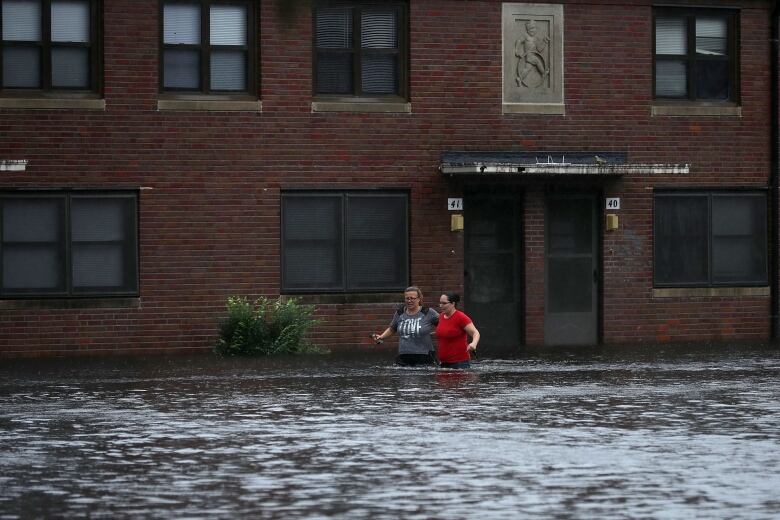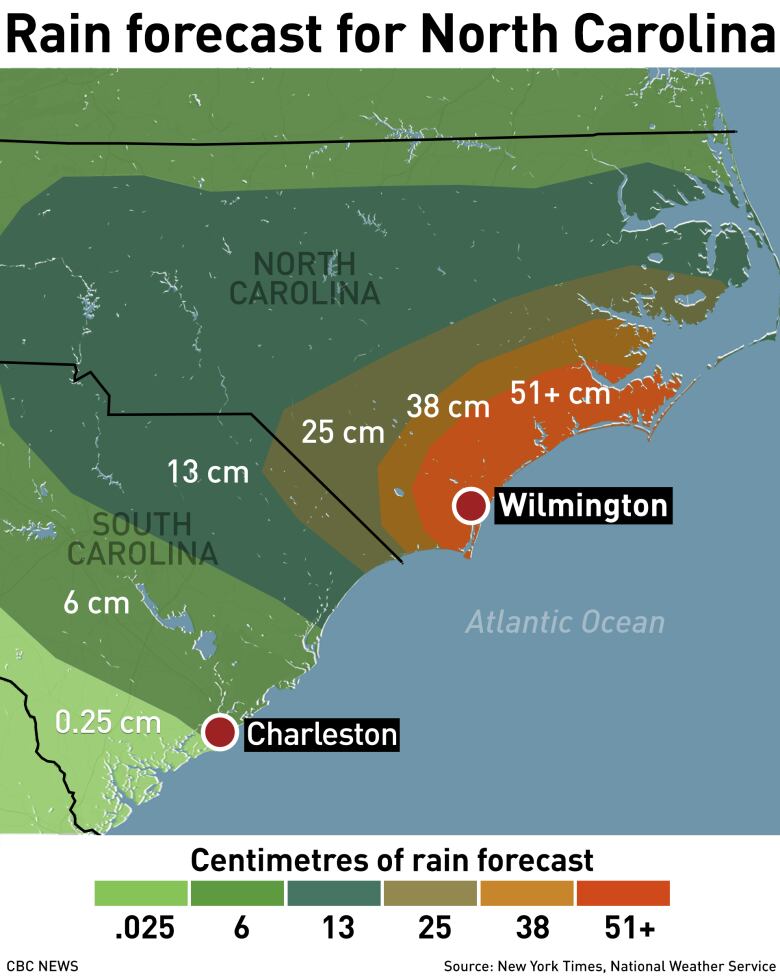'Threat becomes reality' as Hurricane Florence begins days of rain, wind
Florence's winds weakening, but threats from downpours and storm surge remain

Latest
- Storm now a Category 1 hurricane with 144 km/h winds
- Severe flooding possible in both Carolinas
- Governor warns residents not to get complacent as storm weakens
- Tens of thousands without power
- For Friday coverage of Hurricane Florence, click here.
Hurricane Florence's leading edge battered the Carolina coast Thursday, bending trees and shooting frothy sea water over streets on the Outer Banks, as the hulking storm closed in with 144km/hwinds for a drenching siege that could last all weekend. Tens of thousands were without power.
Winds and rain were arriving later in South Carolina, and a few people were still walking on the sand at Myrtle Beach while North Carolina was getting pounded. Heavy rainfall began after dark.
Forecasters said conditions will only get more lethal as the storm smashes ashore early Friday near the North Carolina-South Carolina line and crawls slowly inland. Its surge could cover all but a sliver of the Carolina coast under as much as 3.4 metresof ocean water, and days of downpours could unload more than 90 centimetresof rain, touching off severe flooding.
"Landfall near Wilmington early [Friday] morning is still a possibility, as is the 'stalling out' just before landfall scenario," said Johanna Wagstaffe, CBC meteorologist.
#UnitedStates: #Charleston International Airport and #MyrtleBeach International Airport have suspended operations until #HurricaneFlorence passes. https://t.co/OIDe8lPelm
—@TravelGoCFlorence's winds weakened as it drew closer to land, dropping from a peak of 225 km/hearlier in the week, and the hurricane was downgraded from a terrifying Category 4 to a 1.
'Don't relax, don't get complacent'
But North Carolina Gov. Roy Cooper warned: "Don't relax, don't get complacent. Stay on guard. This is a powerful storm that can kill. Today the threat becomes a reality."
More than 80,000 people were already without power as the storm approached, and more than 12,000 were in shelters. Another 400 people were in shelters in Virginia, where forecasts were less dire.

Forecasters said that given the storm's size and sluggish track, it could cause epic damage akin to what the Houston area saw during Hurricane Harvey just over a year ago, with floodwaters swamping homes and businesses and washing over industrial waste sites and hog-manure ponds.
"It truly is really about the whole size of this storm," National Hurricane Centerdirector Ken Graham said. "The larger and the slower the storm is, the greater the threat and the impact and we have that."
Major test for FEMA
The hurricane was seen as a major test for the country's Federal Emergency Management Agency, which was heavily criticized as sluggish and unprepared for Hurricane Maria in Puerto Rico last year.
As Florence drew near, U.S. President Donald Trump tweeted that FEMA and first responders are "supplied and ready," and he disputed the official conclusion that nearly 3,000 people died in Puerto Rico, claiming the figure was a Democratic plot to make him look bad.
Schools and businesses closed as far south as Georgia, airlines cancelled more than 1,500 flights, and coastal towns in the Carolinas were largely emptied out.
Around midday, Spanish moss blew sideways in the trees as the winds increased in Wilmington, and floating docks bounced atop swells at Morehead City. Some of the few people still left in Nags Head on the Outer Banks took photos of angry waves topped with white froth.
1.7 million warned to flee
Wilmington resident Julie Terrell was plenty concerned after walking to breakfast past a row of shops fortified with boards, sandbags and hurricane shutters.
"On a scale of 1 to 10, I'm probably a 7" in terms of worry, she said. "Because it's Mother Nature. You can't predict."

Forecasters' European climate model is predicting 7.6trillion to 41.6trillion litresof rain will fall on North Carolina over the next week, according to meteorologist Ryan Maue of weathermodels.com. That's enough water to fill the Empire State Building nearly 40,000 times.
More than 1.7 million people in the Carolinas and Virginia were warned to fleeover the past few days, and the homes of about 10 million were under watches or warnings for the hurricane or tropical storm conditions.
The Canadian government has warned citizens against travel to the stretch of the U.S. East Coast that is expected to be hammered by Florence.
Coastal areas like this in Wilmington, NC could see storm surges of up to 3 feet. Other areas as high as 9 feet from #HurricaneFlorence #cbcnews pic.twitter.com/QwjCUslfeq
—@waqascbcMillions could lose power
Homeless after losing her job at Walmart three months ago, 25-year-old Brittany Jones went to a storm shelter at a high school near Raleigh. She said a hurricane has a way of bringing everyone to the same level.
"It doesn't matter how much money you have or how many generators you have if you can't get gas," she said. "Whether you have a house or not, when the storm comes it will bring everyone together. A storm can come and wipe your house out overnight."

Duke Energy Co. said Florence could knock out electricity to three-quarters of its fourmillion customers in the Carolinas, and outages could last for weeks. Workers are being brought in from the Midwest and Florida to help in the storm's aftermath, it said.
As of 11 p.m. ET, Florence was centred about 135 kilometreseast-southeast of Wilmington, its forward movement slowed to 7 km/h. Hurricane-force winds extended 130 kilometresfrom its centre, and tropical-storm-force winds up to 315 kilometres.
Some residents grumble about downgraded storm
A buoy off the North Carolina coast recorded waves nearly ninemetreshigh as Florence churned toward shore.
Scientists said it is too soon to say what role, if any, global warming played in the storm. But previous research has shown that the strongest hurricanes are getting wetter, more intense and intensifying faster because of human-caused climate change.

Florence's weakening as it neared the coast created tension between some who left home and authorities who worried that the storm could still be deadly.
Frustrated after evacuating his beach home for a storm that was later downgraded, retired nurse Frederick Fisher grumbled in the lobby of a Wilmington hotel several kilometresinland.
"Against my better judgment, due to emotionalism, I evacuated," said Fisher, 74. "I've got four cats inside the house. If I can't get back in a week, after a while they might turn on each other or trash the place."
Authorities pushed back against any suggestion the storm's threat was exaggerated.

The police chief of a barrier island in Florence's bulls'-eye said he was asking for next-of-kin contact information from the few residents who refused to leave.
"I'm not going to put our personnel in harm's way, especially for people that we've already told to evacuate," Wrightsville Beach Police Chief Dan House said.
With files from CBCNews












_(720p).jpg)


 OFFICIAL HD MUSIC VIDEO.jpg)
.jpg)



























































































